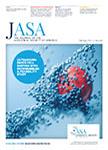版权所有:内蒙古大学图书馆 技术提供:维普资讯• 智图
内蒙古自治区呼和浩特市赛罕区大学西街235号 邮编: 010021

作者机构:Graduate Program in Architectural Acoustics Rensselaer Polytechnic Institute 110 8th Street Greene Building Troy NY 12180clapps@rpi.edu Arup Acoustics New York NY Graduate Program in Architectural Acoustics Rensselaer Polytechnic Institute Troy NY
出 版 物:《The Journal of the Acoustical Society of America》
年 卷 期:2012年第132卷第3_SUPPLEMENT期
页 面:2058-2058页
学科分类:07[理学] 082403[工学-水声工程] 08[工学] 070206[理学-声学] 0824[工学-船舶与海洋工程] 0702[理学-物理学]
摘 要:The most well-known acoustical parameters - including Reverberation Time, Early Decay Time, Clarity, and Lateral Fraction - are measured using data obtained from omnidirectional or figure-of-eight microphones, as specified in ISO 3382. Employing a multi-channel receiver in place of these conventional receivers can yield new spatial information about the acoustical qualities of rooms, such as the arrival directions of individual reflections and the spatial homogeneity. In this research, a spherical microphone array was used to measure the room impulse responses of a number of different concert and recital halls. The data was analyzed using spherical harmonic beamforming techniques together with Bayesian inference to determine both the number of simultaneous reflections along with their directions and magnitudes. The results were compared to geometrical acoustic simulations and used to differentiate between listener positions which exhibited similar values for the standard parameters.